| |
|
|
|
|
| |
The Protest |
|
|
|
| |
|
|
|
|
| |
Big Trees Destroyed |
|
The Treesit |
|
| |
The Parking Lot |
|
FROG "Ribbits" |
|
| |
Friends of Cathedral Grove (FROG) |
|
Cathedral Canyon |
|
| |
|
|
|
|
| |
|
|
| |
|
|
|
|
| |
The Treesit
Efforts to preserve Cathedral Grove on Vancouver Island in British Columbia (BC) began in 1901 and have continued ever since. Protecting the endangered big trees from the clearcut fate of the surrounding ancient forests by taking to task the powerful logging companies and their government cronies has been a rough battle for environmentalism. Dedicated community members and citizens have collected biological data, prepared reports and made posters, conducted tours and given presentations, held meetings and organized protests, written letters, signed petitions and initiated court challenges. In response to the government's 2004 parking lot plan, a treesit and base camp were founded (right). The treesit continued for over two years until the plan to encroach on the big trees was abandoned. |
|

Treesit base camp, Cathedral Grove, 2004
Photo: Ingmar Lee |
|
| |
|
|
 |
|
| |

View down from the treesit platform, 2005.
Photo: Ingmar Lee (Click to enlarge)
The treesit was established in October 2004 to defend the frontline at Cathedral Grove by direct action and non violent civil disobedience. This was the only way that forest activists were able to prevent the BC government from going ahead with its short-sighted scheme to build a huge parking lot for visitors to the park in the middle of a sensitive floodplain on Cameron River that is home to one of the last remaining stands of ancient fir forest on Vancouver Island. |
|
The Cathedral Grove Treesit involved a series of platforms erected in the big trees from which the climbers could keep vigil over any incursions into the area intended to be razed for a parking lot. The height of one treesit platform can be sensed in the photo (left), taken from above looking down; a tiny figure with raised up arms (white circle) is scarcely discernable. Another photo taken from the platform shows the photographer's shoe and a view down to the base camp (below).

View down from the treesit platform.
Photo: Ingmar Lee (Click to enlarge) |
|
| |
|
|
 |
|
| |
The forest is a peculiar organism of unlimited kindness
and benevolence that makes
no demands for its sustenance and extends generously the products of its life
and activity; it affords protection to all beings – Buddhist Sutra |
|
| |

Cathedral Grove Treesit and Procyon Lotar Base Camp at dusk with anti Weyerhaeuser banner, July 2004.
Photo: Ingmar Lee |
|
| |
|
|
 |
|
| |
The Cathedral Grove treesitters chose the nocturnal black-masked racoon, named "Procyon Lotor" by Linnaeus, as their mascot. Racoons typically live in wet forested areas and although they spend most of their time on the ground, they are excellent climbers. The Procyon Lotor Base Camp was set up beside the Cameron River, which runs through Cathedral Grove (above). Marking the camp was a large banner covered with a mugshot of the BC premier, a convicted drunk driver and a logging industry lackey. The provocative banner was made by the well known BC forest activist:
Ingmar Lee. As a veteran tree planter of 21 years, Ingmar Lee has seen first hand the rapacious destruction of old growth forests across the province (right).

Ingmar Lee climbing an ancient cedar tree.
Photo: Karen Wonders
Irreplaceable record sized big trees in the Upper Walbran have been massacred by the wood products industry. Weyerhaeuser, a primary culprit, was challenged by forest defenders in 2004: "Over the past several months, people have been quietly laying out an infrastructure to defend the forest. We are ready, and we are prepared to fight hard to save the forest, and are willing to risk arrest in doing so. We will fight the Campbell [BC premier] wilderness wreckers using direct action, non violent civil disobedience tactics, and it will be a great challenge for them to extract us from the forest and arrest us. A core of very determined and conscientious forest defenders have thus far heroically staved off the destruction of the forest, and many of them have incurred considerable personal expense in doing so"
Cathedral Grove Treesit Chronicle. |
|

Ingmar Lee, forest activist, 2004.
Photo: Karen Wonders
To draw public attention to the destruction of the last ancient forest remnants on Vancouver Island, Ingmar Lee and other forest activists hold tree climbing workshops. In the photo on the left, Lee is seen hoisting his protest banner up a huge cedar tree in the Upper Walbran Forest, an area a few hours from Victoria (the capital city of BC) that is being clearcut. Below, a novice female climber is instructed by Lee on the same unprotected cedar tree, a specimen of some 1,000 years in age.

Forest activist climbing cedar, 2004.
Photo: Karen Wonders |
|
| |
|
|
 |
|
| |

Ingmar Lee on a treesit platform, 2005.
Photo: Richard Boyce
Treesitting has become widespread on the West Coast as a defense tactic to prevent the felling of ancient big trees, the vanishing hallmarks of the native wild forest. It is a desperate measure made necessary by the logging industry's eagerness to grab the very last, lucrative old growth resources as part of their liquidation scheme. |
|
The photo on the left was taken by FROG climber Richard Boyce (see his right boot) on the 60 meter (180 ft) high treesit platform. Ingmar Lee is
seen eating his lunch while enjoying the lofty view over the ancient temperate rainforest canopy. See the video:
World's Highest Treesit.

Ingmar Lee on rappel down from treesit.
Photo: Richard Boyce |
|
| |
|
|
 |
|
| |

Procyon Lotor Base Camp, 2005.
Photo: Ingmar Lee
Part of the Cathedral Grove tree protection strategy was to put the blame for the ongoing diminishment of the small park squarely on logging companies such as Weyerhaeuser. Activists wore t-shirts emblazoned with "BC Forest Crimes Unit" (right), as done by Greenpeace to focus on the real perpetrators of environmental crimes. Not only is the BC Forest Practices Code designed to serve logging companies, but its forest protection clauses are rarely enforced by the industry's government handmaidens. |
|

"BC Forest Crimes Unit," Cathedral Grove.
Photo: Janette Briere |
|
| |
|
|
 |
|
| |

Forest activists, Cathedral Grove, July 2004.
Photo: Janette Briere (Click to enlarge)
The Friends of Cathedral Grove (FROG) posed for a group photo in 2004 beneath the banner that proclaimed their dedication to "Protecting Park Values" (right and above). Spokesperson Ingmar Lee made sure that the goals of FROG were clearly articulated: "We want the world to know that industrial logging is behind the destruction of the primaeval Douglas fir ecosystem of Vancouver Island. We have decided that as citizens of British Columbia, it is our duty to protect the Cathedral Grove forest. Our infrastructure of defense for the big trees includes eight treesitting platforms, all interconnected by an extensive traverse network of ropes through the canopy of the ancient forest. We are prepared to fight to save the forest and risk arrest in doing so." |
|

Forest activists, July 2004.
Photo: Janette Briere |
|
| |
|
|
 |
|
| |

"Cathedral Grove: Protecting Park Values."
Photo: Ingmar Lee
Media attention to the Cathedral Grove Treesit was mostly positive (right). "Part of our ongoing defense infrastructure work has been to continue randomly expanding out our spiders web of traverses throughout the threatened forest. As we have been working at the canopy level, most of these ropes cannot be seen from the ground, but we're not worried if some of them can be seen, and have even flagged a few"
Cathedral Grove Treesit Chronicle. |
|

"Soldiers of Cathedral Grove."
Photo: John McKay/Times Colonist |
|
| |
|
|
 |
|
| |

Friends of Cathedral Grove, 2005.
Photo: anon (Click to enlarge)
The Friends of Cathedral Grove (FROG) is a diverse group of individuals (above) who share a dedication to protecting the big trees from government mismanagement and corporate logging unscrupulousness. FROG was not fooled by the bogus PR public process meetings staged by the government as a last ditch attempt to save face. Trying to squelch widespread community opposition, on 15 November 2005 the BC Minister of Environment threatened to shut down Cathedral Grove. Given that
the popular park attracts international tourism to BC and was voted one of Canada's natural wonders, this represented a form of blackmail. |
|
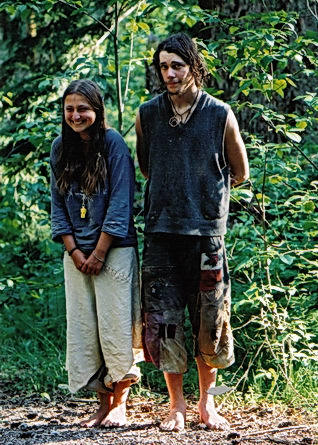
Forest defenders, Cathedral Grove.
Photo: Ingmar Lee |
|
| |
|
|
|
|
| |
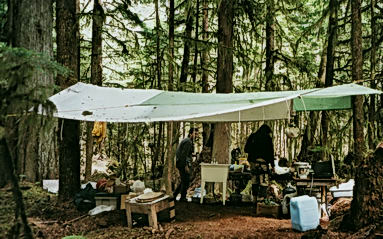
Treesit kitchen, Cathedral Grove, August 2004.
Photo: Karen Wonders |
|

Treesit activist Nick, Cathedral Grove.
Photo: Karen Wonders |
|
| |
|
|
 |
|
| |
An invitation to forest lovers from around the world: "Come visit the Procyon Lotor Base Camp at Cathedral Grove and help defend the Big Trees. Regular tree climbing, platform-building and banner-making workshops are being conducted. This is a great opportunity to conduct a personal retreat while protecting forests. There are dedicated tent and cooking platforms with radio commmunication . . . "

Winter Solstice, 21 December 2005.
Photo: Richard Boyce |
|
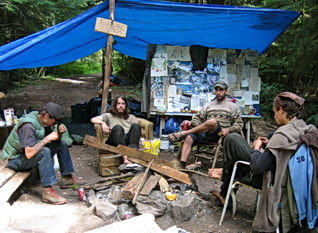
Treesit activists, 26 July 2005.
Photo: Karen Wonders
Ingmar Lee continues his invitation: "We even offer hot showers in the trees. Of course, if you want privacy during your retreat, just pull up the rope! This is a lean, efficient, unorganized, grassroots effort with people working together across a wide variety of skill sets. We embrace the widest diversity to accomplish our goal of protecting this ancient forest once and for all"
Cathedral Grove Treesit Chronicle. |
|
| |
|
|
 |
|
| |
Anti-Weyerhaeuser sentiment is widespread in the local communities who are dependent on the sustainable harvesting of the quickly diminishing forest resources. They have seen how massive clearcutting by the American logging corporation has violated the spiritual sites of First Nations, devasted prime salmon streams through sedimentation and disrupted the hydrology of their drinking watersheds, contaminating their water with toxic industrial chemicals.
A Cathedral Grove Treesit poster (right) calls for direct action and non violent civil disobedience to continue the grass roots defense of the big trees that began in March 2004 and continued for more than 24 months until the BC government back down from its planned encroachment. The sentiment of the treesitters is expressed on a t-shirt (below).

Treesit activist T-shirt, 2005.
Photo: Ingmar Lee |
|

Please Help Defend This Forest!
Treesit Poster (Click to enlarge)
Logging corps change names to pass the buck and avoid public condemnation while continuing business as usual. Since 2005 Weyerhaeuser's "incarnation" on Vancouver Island was variously maneuvered, the latest being Island Timberlands, a Bermuda based subsidiary of the transnational corporation Brookfield Assets Management. |
|
| |
|
|
|
|
| |

"Weyerhaeuser: Go Home," anti logging banner, Cathedral Grove, July 2004.
Photo: Richard Boyce |
|
| |
|
|
 |
|
| |

Cathedral Grove Treesit climbers, 2005.
Photo: Ingmar Lee
"We've made comprehensive public announcements about the traverse networks, to make it clear to all parties that if anyone insists on cutting Cathedral Groves trees, they will need to climb every tree to see whether there's a rope on it before a single one is cut down. These are huge trees and to climb each one will require a lengthy operation conducted by an expensive team of professional climbers. In the event of forced removal, the rope clearing effort buys significant extra time, even after the sitters have been removed"
Cathedral Grove Treesit Chronicle. |
|

Treesit platform, 2005.
Photo: Ingmar Lee |
|
| |
|
|
|
|
| |

Looking down from treesit platform, 2005.
Photo: Richard Boyce
The spectacular view down from one of the Cathedral Grove Treesit platforms gives an impression of the great height of the Douglas fir tree (above). The blue tarp covered platform seen in the photo on the right was installed at about 50 meters up the branchless trunk of another ancient Douglas fir nicknamed the "Minaret" by the treesitters (right). According to Ingmar Lee, "This is one of the highest treesits in the world and requires a breath taking climb with no comforting branches to dispell the vertigo." |
|

View up at the "Minaret" treesit platform.
Photo: Richard Boyce |
|
| |
|
|
 |
|
| |

Anti-Weyerhaeuser banner, July 2004.
Photo: Ingmar Lee |
|

|
Kick Weyerhaeuser off the World!
World's Worst Wilderness Destroyer
Everything's Wrong with 'W'
Destroyer of Ancient Forests
Extinction of the Vancouver Island Marmot
Massive Raw Log Export
Ruination of the Nanaimo Drinking Watershed
Log & Flog of Valdes Island
Trasher of East Creek & the Walbran |
When the American tree killing company Weyerhaeuser abandoned its coastal logging operations in BC in May 2005, there was a sense of relief among the Cathedral Grove activists, although voracious clearcutting continues. |
|
| |
|
|
 |
|
| |

Cathedral Grove Treesit Trail, 2005.
Photo: Richard Boyce
To help educate people visiting Cathedral Grove, the treesitters conducted walking tours through the unprotected areas adjacent to the park. Preferably people walked along the trail in barefeet so that the thick spongy biomass of the ancient forest floor on the floodplain of Cameron River could be experienced firsthand (above and right). |
|
Sunshine Goldberry, a FROG and community member expressed her frustration: "I'm mad at the logging companies for endangering the Park, mad at the government in charge of cutting rights. And, I'm really upset at the Parks guys who let this happen on their watch. No way will they put a Parking lot in what is left of protection for the old growth behind them. Visitors along the highway have no idea what is going on here!"

Cathedral Grove, "Barefeet Please."
Photo: Richard Boyce |
|
| |
|
|
 |
|
| |
On 5 April 2006, the BC Ministry of Environment announced that it would not be proceeding with its planned parking lot for Cathedral Grove. In response, a spokesperson for FROG reported: "As a sign of good faith FROG has removed the 24 hour vigil that has protected the area from destruction for the past two
years. We hope that these steps forward will provide the atmosphere to implement a transparent public process that will address many of the concerns that were brought to the forefront when parking lot plans were unveiled in 2001 after minimal public consultation."

Cathedral Grove Treesit tent, 2005.
Photo: Ingmar Lee
In addition to the unethical destruction of ancient termperate rainforest biodiversity, the forest industry has ruined countless sites of irreplaceable aboriginal heritage and deprived the indigenous peoples who have stewarded the forests for thousands of years of economic benefits from their harvesting. With all that has been lost – in many instances due to illegal land grabs – it is unacceptable that today the clearcutting continues in the forests adjacent to Cathedral Grove, which are full of culturally modified trees such as the two bark stripped cedars (right).
Weyerhaeuser secretively engineered the removal of 70,300 hectares from Tree Farm Licence 44 in 2004. Most of this land, which includes the Cathedral Grove Watershed, is in the traditional territory of the Hupacasath First Nation. In 2005 and again in 2008 Hupacasath Chief Councillor Judith Sayers launched legal action against the BC Ministry of Forests and Weyerhaeuser – Brascan – Island Timberlands. In two groundbreaking decisions, the court ruled that the Crown had a duty to consult with and accommodate the Hupacasath. Sayers explained why the Hupacasath took action: "The forests are our cathedrals and our interest is to protect that which most sacred and precious to us" 4 November 2008, Hupacasath First Nation:
Press Release. |
|

Cathedral Grove Treesit Camp, 2005.
Photo: Ingmar Lee
Once again the encroachment of Cathedral Grove was thwarted by dedicated forest activists and community members. The long and tortuous history of park protection that characterizes this type of rare and vanishing old growth ecosystem in BC was caused by its relentless commercial exploitation by the greedy forest industry.

Culturally modified trees, Cathedral Grove.
Photo: Ingmar Lee |
|
| |
|
|
 |
|
| |
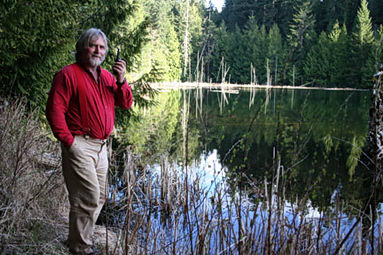
FROG Phil Carson, Cameron River, 3 May 2006.
Photo: Scott Tanner
To celebrate the Cathedral Grove Treesit victory and the closing of the Procyon Lotar Base Camp, on site festivities were held on 26 April 2006 (right). Forest activists and community members attended, including the legislative representative for Alberni Qualicum, Scott Fraser (centre), who is working with Phil Carson and others to condemn the current logging of Cathedral Canyon by Island Timberlands. |
|
FROG worked respectfully with First Nations, with Hupacasath Chief Councillor Sayers and with Qualicum Chief Recalma – Clutesi and obtained their support for the Cathedral Grove Treesit. Phil Carson (left), a founding FROG, remains a vigilant observer of the logging industry's continued plundering of the Cathedral Grove Watershed.
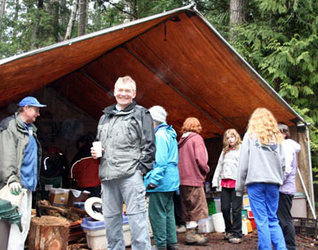
Victory party, 26 April 2006.
Photo: Phil Carson |
|
| |
|
|
|
|
| |

Procyon Lotor Base Camp, Cathedral Grove, Vancouver Island, British Columbia, 2004.
Photo: Ingmar Lee |
|
| |
|
|
 |
|
| |
|
|
| |
©
Contact & Credits |
|
| |
|
|
|
|

